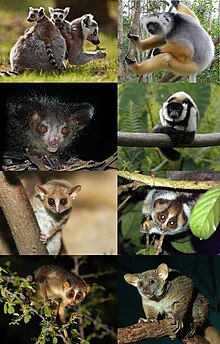Lemuriformes
| Lemuriformes Temporal range: Paleocene to present |
|
|---|---|
 |
|
| A sample of lemuriform diversity; 8 biological genera are depicted (from top, left to right): Lemur, Propithecus, Daubentonia, Varecia, Microcebus, Nycticebus, Loris, Otolemur. | |
| Scientific classification | |
| Kingdom: | Animalia |
| Phylum: | Chordata |
| Class: | Mammalia |
| Order: | Primates |
| Suborder: | Strepsirrhini |
| Infraorder: |
Lemuriformes Gregory, 1915 |
| Superfamilies | |
|
Lemuroidea |
|
Lemuroidea
Lorisoidea(See text)
Lemuriformes is an infraorder of primate that falls under the suborder Strepsirrhini. It includes the lemurs of Madagascar, as well as the galagos and lorisids of Africa and Asia, although a popular alternative taxonomy places the lorisoids in their own infraorder, Lorisiformes.
Lemuriform primates are characterized by a toothcomb, a specialized set of teeth in the front, lower part of the mouth mostly used for combing fur during grooming.
Lemuriform origins are unclear and debated. American paleontologist Philip Gingerich proposed that lemuriform primates evolved from one of several genera of European adapids based on similarities between the front lower teeth of adapids and the toothcomb of extant lemuriforms; however, this view is not strongly supported due to a lack of clear transitional fossils. Instead, lemuriforms may be descended from a very early branch of Asian cercamoniines or sivaladapids that immigrated to northern Africa.
Scandentia (treeshrews)
Dermoptera (colugos)
Haplorhini (tarsiers, monkeys, and apes)
Until discoveries of three 40-million-year-old fossil lorisoids (Karanisia, Saharagalago, and Wadilemur) in the El Fayum deposits of Egypt between 1997 and 2005, the oldest known lemuriforms had come from the early Miocene (~20 mya) of Kenya and Uganda. These newer finds demonstrate that lemuriform primates were present during the middle Eocene in Afro-Arabia and that the lemuriform lineage and all other strepsirrhine taxa had diverged before then.Djebelemur from Tunisia dates to the late early or early middle Eocene (52 to 46 mya) and has been considered a cercamoniine, but also may have been a stem lemuriform.Azibiids from Algeria date to roughly the same time and may be a sister group of the djebelemurids. Together with Plesiopithecus from the late Eocene Egypt, the three may qualify as the stem lemuriforms from Africa.
...
Wikipedia
